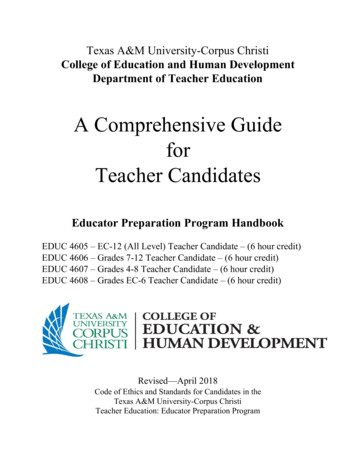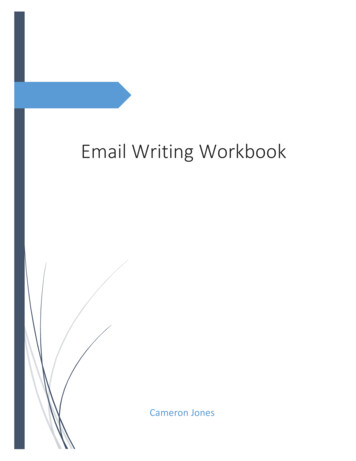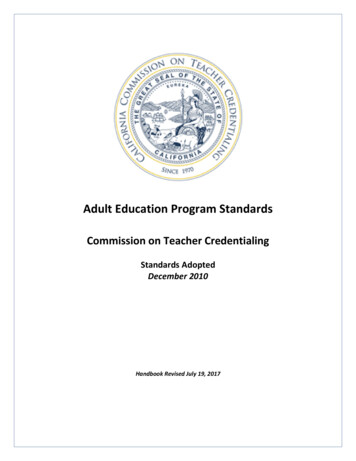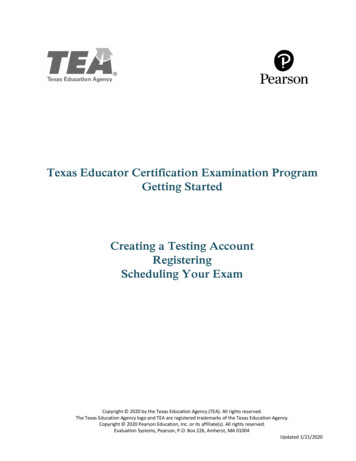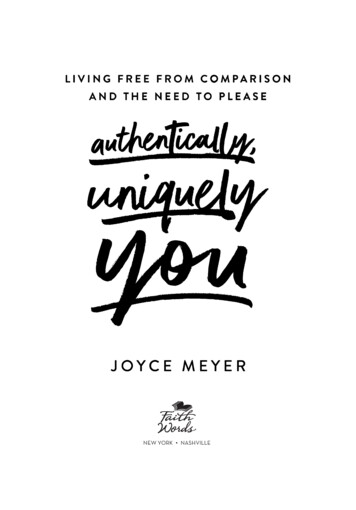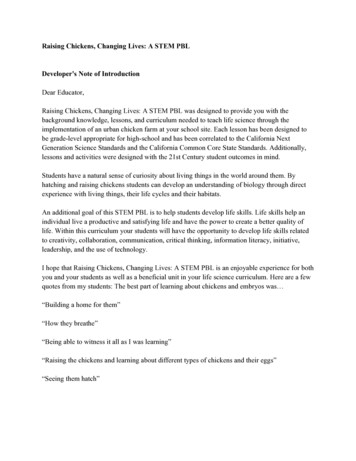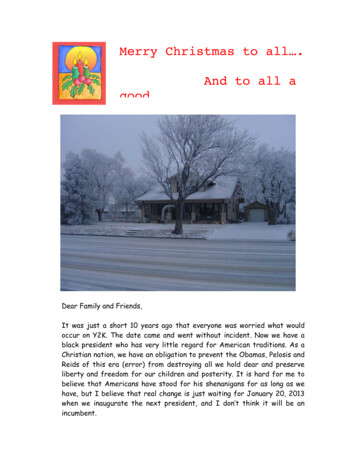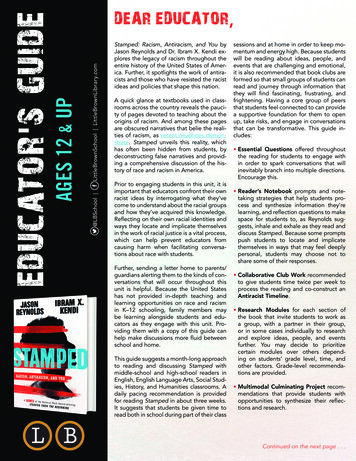
Transcription
LittleBrownSchool LittleBrownLibrary.com@LBSchool AGES 12 & UPeducator's guideDEAR EDUCATOR ,Stamped: Racism, Antiracism, and You byJason Reynolds and Dr. Ibram X. Kendi explores the legacy of racism throughout theentire history of the United States of America. Further, it spotlights the work of antiracists and those who have resisted the racistideas and policies that shape this nation.A quick glance at textbooks used in classrooms across the country reveals the paucity of pages devoted to teaching about theorigins of racism. And among these pagesare obscured narratives that belie the realities of racism, as recent headlines demonstrate. Stamped unveils this reality, whichhas often been hidden from students, bydeconstructing false narratives and providing a comprehensive discussion of the history of race and racism in America.Prior to engaging students in this unit, it isimportant that educators confront their ownracist ideas by interrogating what they’vecome to understand about the racial groupsand how they’ve acquired this knowledge.Reflecting on their own racial identities andways they locate and implicate themselvesin the work of racial justice is a vital process,which can help prevent educators fromcausing harm when facilitating conversations about race with students.Further, sending a letter home to parents/guardians alerting them to the kinds of conversations that will occur throughout thisunit is helpful. Because the United Stateshas not provided in-depth teaching andlearning opportunities on race and racismin K–12 schooling, family members maybe learning alongside students and educators as they engage with this unit. Providing them with a copy of this guide canhelp make discussions more fluid betweenschool and home.This guide suggests a month-long approachto reading and discussing Stamped withmiddle-school and high-school readers inEnglish, English Language Arts, Social Studies, History, and Humanities classrooms. Adaily pacing recommendation is providedfor reading Stamped in about three weeks.It suggests that students be given time toread both in school during part of their classsessions and at home in order to keep momentum and energy high. Because studentswill be reading about ideas, people, andevents that are challenging and emotional,it is also recommended that book clubs areformed so that small groups of students canread and journey through information thatthey will find fascinating, frustrating, andfrightening. Having a core group of peersthat students feel connected to can providea supportive foundation for them to openup, take risks, and engage in conversationsthat can be transformative. This guide includes: Essential Questions offered throughoutthe reading for students to engage within order to spark conversations that willinevitably branch into multiple directions.Encourage this. Reader’s Notebook prompts and notetaking strategies that help students process and synthesize information they’relearning, and reflection questions to makespace for students to, as Reynolds suggests, inhale and exhale as they read anddiscuss Stamped. Because some promptspush students to locate and implicatethemselves in ways that may feel deeplypersonal, students may choose not toshare some of their responses. Collaborative Club Work recommendedto give students time twice per week toprocess the reading and co-construct anAntiracist Timeline. Research Modules for each section ofthe book that invite students to work asa group, with a partner in their group,or in some cases individually to researchand explore ideas, people, and eventsfurther. You may decide to prioritizecertain modules over others depending on students’ grade level, time, andother factors. Grade-level recommendations are provided. Multimodal Culminating Project recommendations that provide students withopportunities to synthesize their reflections and research.Continued on the next page . . .
EDUCATOR’S GUIDEGlass has been used as a powerful metaphor for reading. Multicultural educator and scholar Dr. Rudine SimsBishop uses it to describe the important purposesbooks serve for students: as mirrors, windows, and sliding glass doors. In his award-winning picture book Martin’s Big Words, illustrator Bryan Collier shares that, tohim, stained-glass windows serve as a metaphor for thelife and work of Dr. Martin Luther King Jr. Glass, too, isa symbol for this unit on Stamped. Students are invitedto peer through the looking glass to learn about thehistory of racist ideas in America. They are challengedto hold up a magnifying glass to identify and examineracist policies that are embedded within the fabric ofthis nation. Students are also empowered to look intothe mirror to locate themselves in the work of stampingout racist thoughts in their lives today. May this bookand this unit provide a window to view the path forward for leading antiracist lives.SUPPORTING NATIONAL ELA ANDSOCIAL STUDIES STANDARDSStamped is a powerful text selection for middle-gradeand high-school students for addressing ELA standards in reading informational texts and Social Studiesstandards such as, but not limited to, the CommonCore Standards (CCSS), and the National CurriculumStandards for Social Studies. Educators are encouraged to think about this text through the lens of theirstate-specific and national standards.ESTABLISHING COMMUNITY AGREEMENTSAlthough race has been an important factor in the waythat the US and all its institutions have been designed,one of the biggest roadblocks to engaging in discourseabout this is discomfort. Conversations about race andracism are inherently uncomfortable. And yet Stamped,as well as frequent news headlines about racist incidents, makes clear that we cannot allow discomfort tobe a deterrent to this work. Instead, with continuedpractice, guided by educators who continuously reflecton and interrogate their own racial identities, theseconversations become easier. Rather than seeking tocreate “safe spaces,” which has become synonymouswith comfort, the goal should be to foster “brave spaces” for conversations about race and racism that aregrounded in mutual respect. Establishing communityagreements and protocols for discussions about race isone way that educators can help students enter thesebrave spaces where listening to and valuing variousperspectives and experiences is central.Establishing community agreements prior to reading Stamped can help support students in having amore meaningful experience as they navigate thiscomprehensive, complex text and examine the ideaswithin it as well as their own. Provide opportunitiesto practice these agreements by facilitating conversations that help students develop a consciousness,or further their awareness, about race. For example,students can reflect on the ways they’ve noticed thatrace matters in society and the ways their racial identities have influenced their lives. Reflecting and sharingresponses in small groups while practicing the community agreements can help students become moreattuned to their own racialized experiences and theracialized experiences of others. Implementing community agreements in classrooms can make it possiblefor discussions about race and racism to be sustainedacross the school year, not simply across one unit or thereading of one text.A NOTE OF CAUTIONIt is important to note that some of the language used in Stamped may be triggering forsome students. It is recommended that educators and students discuss this up front and makedecisions as a community about how they will navigate this in ways that foster a learningenvironment that mitigates the emotional labor of students of color. For example, the N-wordappears in Stamped. Educators can help students understand that this word provokes intenseemotions and reactions based on the truth behind its origins, its historical use toward peopleof color, and the legacy that remains today. A community agreement might include the provision that just because students will read this word doesn’t mean they have to say this wordduring class discussions.
EDUCATOR’S GUIDEDAY 1KEY CONCEPTUnderstanding the legacy of racism in America is essential to building an antiracist America.On this first day of the unit you’ll begin to develop a sense of community among readers as they engagewith ideas and work that will be challenging and transformative. Help students form book clubs thatconsist of four or five students.Read the “Dear Reader” letter by Kendi aloud to students. Use the Essential Questions to framehow they listen to and think about the letter. Students might jot down their ideas on Post-its or in theirReader’s Notebooks. You might also use a document camera to share the Essential Questions and toshow and mark key parts of the letter as students engage in discussion within their book clubs.Students will also read chapter 1 today and discuss the Essential Questions with their book clubmembers.ESSENTIAL QUESTIONS (Opening Letter)So much has been hidden from us. As you listen to this letter to readers by Kendi, think about andprepare to discuss the following: What are the consequences of continued omissions about the history of racism and antiracismin the US? What are the implications for you and the kind of thinking you might undertake, discussions youmight have, and actions you might take up as you read this book?ESSENTIAL QUESTIONS (Introduction)Read the following two sentences from the beginning of the introduction: “To know the past is to knowthe present. To know the present is to know yourself” (p. ix). Ask students to consider the following: How will you locate yourself in the work of antiracism as you read and discuss this book? How might learning about the source of racist ideas help you to know the present and yourself?ESSENTIAL QUESTIONS (Chapter 1) Discuss each of the three positions: assimilationist, segregationist, antiracist. In what ways dopeople, past and present, demonstrate their imperfections by embodying ideas from one ormore of these positions? Reynolds has given Gomes Eanes de Zurara the title “World’s First Racist.” In doing so, Reynolds spotlights the power of the written word and how it can be used as a force for evil. What ishistory? How is history much more than simply a recording of dates and facts that are significantonly to the past?READER’S NOTEBOOKRemind students that their Reader’s Notebook is a place to reflect on ideas they’re learning as well asto construct written responses to the reading. For example, students may capture a brief description ofeach of the three positions in their notebooks and add to their thinking as they continue to read and theirunderstanding deepens. These descriptions can include examples of people and events that supportstudents’ ideas. Encourage note-taking and responses in various forms including charts, diagrams, lists,and other ways students work to process information.HOMEWORK: Read chapters 2 and 3.
EDUCATOR’S GUIDEDAY 2KEY CONCEPTKnitting slavery into America’s religious and educational institutions helped solidify and justify racism.Ask students to read chapter 4. Remind students that, as they read, an overarching goal is to connectissues and events of the past with the present.ESSENTIAL QUESTIONS In what ways is racism woven into the fabric of American institutions? Where do you seeevidence of this today? Zurara’s book The Chronicle of the Discovery and Conquest of Guinea and Cotton Mather’sbook Memorable Providences, Relating to Witchcrafts and Possessions are symbols of thepower and consequences of writing. How does what we read influence our views of the world?READER’S NOTEBOOKInvite students to consider in writing why words such as race and privilege seem to require, as Reynoldssuggests, a “breath break” (p. 21). They might also consider how and why the definition of White shiftsand changes as the institution of slavery is founded, and has continued to, even up to today.HOMEWORK: Read chapter 5.DAY 3KEY CONCEPTRacist ideas were embedded in the formation of the US government by the founding fathers, whosehypocrisy was manifested in documents that proclaimed freedom and equality for all.Ask students to read chapters 6–8. Then provide time for book clubs to discuss the reading, includingthe connections they’ve made between the past and the present.ESSENTIAL QUESTIONS Nigerian author Chinua Achebe (1930–2013) shares the following African proverb in hisacclaimed novel Things Fall Apart: “Until the lions have their own historians, this history of thehunt will always glorify the hunter.” How does Reynolds’s truth-telling about Thomas Jeffersoncompare to narratives typically told about him as one of our nation’s founding fathers? Howdoes this African proverb help shed light on why the storyteller matters when learning aboutevents of the past and present? Evaluate the following statement: “Racism is the bedrock of the USA.” How are the forming ofour nation’s government and the policies and practices of today emblematic of this statement?READER’S NOTEBOOKHave students create a chart that helps them track and analyze the ways race influences social,economic, and political conditions for African Americans.In addition to noting examples of the ways racism has been embedded in the policies and practices ofour nation, students might also write about how they’ve come to develop understandings about race.Invite students to consider the messages they’ve learned about race from the media, their family, community, school, and peers.HOMEWORK: Read chapters 9 and 10.
EDUCATOR’S GUIDEDAY 4COLLABORATIVE CLUB WORKInhale. Exhale. Ask students to work collaboratively with their clubs to process all that they’ve been reading and learning. This is a sample script:“Today you’ll begin to co-construct an Antiracist Timeline that includes the antiracists you’ve beenreading about, the work they’ve done, and how they’ve resisted racists and racism. Because you willbe adding to this Antiracist Timeline throughout the unit, you’ll want to construct it on paper thatyou trim and/or connect with tape to give you the space needed for this ongoing work. Also, you willwant to use different sized Post-it notes for the names of people and events. That way, you’ll havethe ability to move ideas around and make space for others as you are presented with new information as you read.”“Kendi asserts, ‘The first step to building an antiracist America is acknowledging America’s racistpast. By acknowledging America’s racist past, we acknowledge America’s racist present. In acknowledging America’s racist present, we can work toward building an antiracist America’ (p. xv). Therefore, the last entry on this timeline will be about each of you. So as you continue to read andco-construct this Antiracist Timeline, keep thinking about the question you considered on Day 1 ofthis unit: How will you locate yourself in the work of antiracism as you read and discuss this book?”READER’S NOTEBOOKSuggest to students that they create and continue to develop a chart of the antiracists they’re learningabout as they read Stamped. As they consider how they will locate themselves in the work of antiracism,they can return to this chart to list and reflect on the words and actions of these antiracists and how theycan be mentors for them.HOMEWORK: Read chapters 11 and 12.DAY 5KEY CONCEPTRacist ideas, along with economic greed, are central to the formation of this nation, its laws, policies,and practices. Meritocracy and the American Dream narrative are rooted in whiteness.Ask students to read chapters 13 and 14. Use the following Essential Questions to help frame andsupport students’ discussions as they make connections between the past and the present.ESSENTIAL QUESTIONS At the beginning of Stamped and in chapter 13, Reynolds asserts, “Life rarely fits neatly into abox. People are complicated and selfish and contradictory.” Who are some of the complicatedpolitical figures, past and present, and what makes them complex? Reynolds uses the following simile to describe racism: “Freedom in America was like quicksand.It looked solid until a Black person tried to stand on it. Then it became clear, it was a sinkhole”(p. 108). He also uses the following metaphors and descriptors: “racist roadblocks,” “racistloopholes,” “potholes,” and “political and physical violence working to break the bones ofBlack liberation” (p. 109–110). In what ways is racism embedded in practices, policies, and laws?What parallels can you draw between the past and present ways racist roadblocks, potholes,and loopholes continue to persist? Reynolds names the Thirteenth, Fourteenth, and Fifteenth Amendments each as an exampleof a “big deal” that is far from a “done deal” (p. 110). When it comes to racism, why must wenever let our guards down?READER’S NOTEBOOK/HOMEWORKAsk students to reflect on the following question and respond in their Reader’s Notebooks: How is yourracial consciousness being challenged or changed as a result of reading and discussing Stamped?
EDUCATOR’S GUIDEDAY 6COLLABORATIVE CLUB WORKInhale. Exhale. Ask students to continue to co-construct their Antiracist Timeline that includes the antiracists they’ve been reading about, the work they’ve done, and how they’ve resisted racists and racism.What matters is not the wrongness or rightness of this work, but that students are grappling with thecomplexity of the people and events they’re learning about and working together to understand thework of antiracists. Guide students in this work. For example, if students are wrestling with whether complicated figures like W. E. B. Du Bois should be positioned on the timeline, you might suggest that thenames of some people be placed above or below the timeline until students deem whether their wordsand actions live up to their being an antiracist. Other figures may not be positioned on the timeline atall, and students can determine how and where to position them in their work later.HOMEWORK: Read chapters 15 and 16.DAY 7KEY CONCEPTRacist ideas are exposed within the complicated and contradictory approaches to liberation by Blackassimilationists as well as in literature and media.Ask students to read chapter 17. Facilitate and support discussions in ways that help students bridgeevents in the past to the present, helping them draw upon experiences in their local contexts and communities and those they’ve learned about in the headlines.ESSENTIAL QUESTIONS Du Bois and Booker T. Washington had distinct strategies and approaches to Black liberation.What does liberation mean to you? In what ways are some approaches to liberation in fact notalways liberatory? Reynolds discusses The Souls of Black Folk by Du Bois and Du Bois’s concept of “double consciousness.” “A two-ness. A self that is Black and a self that is American” (p. 124). In what waysmight people feel as if their identity is divided? In what ways might people feel as if their identityis unified?READER’S NOTEBOOKInvite students to list some of their identities. Ask them to consider whether they feel as if their identityis divided in some way. If so, they might draw a line between those identities on their list to demonstratehow. Then, have students write about the ways they experience what Reynolds calls a “two-ness.”Students might also respond to the questions posed by researcher and scholar Dr. Beverly Daniel Tatumin the following quote: “The concept of identity is a complex one, shaped by individual characteristics,family dynamics, historical figures, and social and political contexts. Who am I? The answer depends inlarge part on who the world around me says I am. Who do my parents say I am? Who do my peers sayI am? What message is reflected back to me in the faces of teachers, my neighbors, store clerks? Whatdo I learn from the media about myself? How am I represented in the cultural images around me? Or amI missing from the picture altogether?” (Tatum, B. D. [2000]. The complexity of identity: “Who am I?” InAdams, M., Blumenfeld, W. J., Hackman, H. W., Zuniga, X., Peters, M. L. [Eds.], Readings for Diversityand Social Justice [pp. 9–14]. New York: Routledge.)HOMEWORK: Read chapter 18.
EDUCATOR’S GUIDEDAY 8KEY CONCEPTFrom assimilationist to antiracist—a transformation of Du Bois and his politics begins as young leaderslaunch new movements for the liberation of Black people.Ask students to read chapter 19.ESSENTIAL QUESTIONS Marcus Garvey spotlighted the issue of colorism, its origins, and the dangers of it. Is colorismequally as destructive as racism? Reynolds demonstrates how racist ideas in the fields of science and mathematics—from eugenics to the creation and purposes of IQ and standardized tests—have been created and used tooppress Black and Brown people. How do we decide what to believe about a scientific claim? Stamped traces Du Bois’s complicated stance on race and racism. In what ways do assimilationist, segregationist, or antiracist stances show up in your daily lives?READER’S NOTEBOOKAsk students to draft an infographic in their Reader’s Notebook that summarizes what they’re learningabout a particular topic, event, or person. As students look across the research they’ve collected whilereading Stamped and engaging with some of the Research Modules, they can consider the purposeof their infographic. If their goal is to inform, they might create a pictograph. To compare, they mightconstruct a bar, pie, or stacked-column chart. To show change, they might use a timeline or line chart.Encourage students to consider how color, headers, and the size of words can help them communicateideas easily and clearly. Later, they might use this notebook draft to create a digital version.HOMEWORK: Read chapter 20.DAY 9COLLABORATIVE CLUB WORKInhale. Exhale. Ask students to continue working on their Antiracist Timelines with their club members.Remind students that the goal of this work is to process and reflect on all they are learning and discussing as they read Stamped. They may need to add more paper to extend the length of their timelinesto reflect the names and events they’ve been reading about. Students may also choose to create andattach QR codes to digital resources they’ve accessed in their research on particular modules that canenhance antiracist understandings. Essentially, this timeline will capture what the work of antiracismlooks like to better understand how to build an antiracist America.HOMEWORK: Read chapters 21 and 22.
EDUCATOR’S GUIDEDAY 10KEY CONCEPTBlack antiracists and Black political movements work to affirm the racial identities of Black people andtheir right to do more than just survive.Ask students to read chapter 23.ESSENTIAL QUESTIONS When describing Black political movements such as the Mississippi Freedom Democratic Party(MFDP) and the Student Nonviolent Coordinating Committee (SNCC), Reynolds states, “Theshift went from fighting for civil rights to fighting for freedom. The difference between the twois simple. One implies a fight for fairness. The other, a right to live” (p. 175). Expound on thisidea. In what ways do you make a distinction between fairness and life? Racism is so embedded in our lives that even everyday expressions that might seem innocuous are in fact examples of the pervasive power of language and the ways words and phrasesassociate blackness with negativity. Examples include words and phrases such as black sheep,blackballing, blackmail, blacklisting, black mark, and blackout. Other words and phrases includeminority, ghetto, thug, and inner city. Discuss the ways Reynolds sheds light on how Blackpeople have worked collectively to resist such negativity. To what extent do all citizens of ademocratic society have a responsibility to disrupt the racism that is embedded in the Englishlanguage?READER’S NOTEBOOK/HOMEWORKAsk students to reflect on the following and respond to the questions in their Reader’s Notebooks. Stereotypes are learned and pervade our society, even if we don’t agree with them. What stereotypes aboutpeople based on race do you know? Which stereotypes have you learned, which therefore influenceyour perception of people?DAY 11COLLABORATIVE CLUB WORKInhale. Exhale. Ask students to continue working on their Antiracist Timelines with club members andremind them to revisit previous ideas and revise or extend their thinking. For example, ask students toconsider how their thinking about Du Bois is evolving and how they might demonstrate this. Also, askhow they might account for the silencing of antiracist leaders such as Bayard Rustin, James Baldwin, andMalcolm X during the March on Washington, as well as the overall silencing of Black women such as Angela Davis, on their timelines. Challenge students to reflect and recognize that the work of antiracism isjust that. Work! Remind students to contribute their work and ideas from the Research Modules they’veengaged with in the co-construction of this timeline.HOMEWORK: Read chapter 24.
EDUCATOR’S GUIDEDAY 12KEY CONCEPTRacist ideas entrenched in political campaigns and presidencies wage war on the Black community.Ask students to read chapter 25.ESSENTIAL QUESTIONS Discuss the legacy of coded racial policies such as the Southern Strategy, the War on Drugs,and the Violent Crime Control and Law Enforcement Act that devastated Black communitiesand the ways this continues today. How do racist policies tarnish or delegitimize the ideals andpurposes of government? Watch the video for “Fight the Power” by Public Enemy. How was the emergence of hip-hopmusic a force for “driving change and empowerment” (p. 211)? In what ways does “Fight thePower” offer a powerful critique of mainstream America that is still relevant today? Who or whatis the power?READER’S NOTEBOOKInvite students to think more about power and resilience. They might reflect on the following questionsin their Reader’s Notebooks as they read Stamped and examine their own lives: Who has power? How isit used? How do people respond to injustice? In what ways do they take action?HOMEWORK: Read chapter 26.DAY 13KEY CONCEPTRacist ideas rooted in legislation shape the institution of education and its outcomes for Black children,while the nation’s leaders assert that color blindness is the solution for racism.Ask students to read chapter 27.ESSENTIAL QUESTIONS In Stamped, Reynolds exposes and debunks the myths of several master narrative themes suchas: America is a meritocracy and anyone who works hard enough can succeed; truth and justice(or law and order) should be valued; people should be colorblind. In what ways is a color blindness approach toward race not only disingenuous but dangerous? Researcher and scholar Dr. Richard Milner IV argues that race is constructed physically, contextually, socially, legally, and historically. (Rac[e]ing to Class: Confronting Poverty and Racein Schools and Classrooms, Harvard Education Press, 2015.) How strong is the evidence thatReynolds and Kendi present to support Milner’s assertion?READER’S NOTEBOOKChallenge students to think about how closely examining and interrogating their own lives can provideinsight into how they can disrupt racism. Encourage them to use their Reader’s Notebooks as a space todo this work, responding to questions such as: Who are the people that are part of your daily life (family,friends, teachers, teammates, etc.)? How many are from a cultural, language, or social-class backgroundthat differs from your own? How does this influence your understandings about race and racism?HOMEWORK: Read chapter 28.
EDUCATOR’S GUIDEDAY 14COLLABORATIVE CLUB WORKPrior to clubs working on their Antiracist Timelines, read the afterword aloud to students as a way tobring the reading of Stamped to a close as a community.Provide students with time to independently reflect on and respond to the following questions in theirReader’s Notebooks: What have you learned about how racism works and the work of antiracism? Howhas your racial consciousness been challenged or changed as a result of reading Stamped? Then invitestudents to share their thoughts with their club members.With the remaining class time, ask students to continue working on their co-constructed AntiracistTimelines. Remind them of Kendi’s assertion: “The first step to building an antiracist America is acknowledging America’s racist past. By acknowledging America’s racist past, we acknowledge America’s racistpresent. In acknowledging America’s racist present, we can work toward building an antiracist America”(p. xv). Ask students to consider how they locate themselves in the work of antiracism. Encourage students to consider their responses to the reflection questions in their Reader’s Notebook today and usethem to position themselves on their timeline along with the antiracist work they have done and pledgeto do.DAYS 15–19Provide students time to finalize their Antiracist Timelines and to determine the Multimodal CulminatingProject they’d like to develop, which will be shared with the class on Day 20. Educators may decide withstudents whether the work they have done on Research Modules throughout this unit will be used in theculminating projects.DAY 20Invite students to share their Antiracist Timelines and Multimodal Culminating Projects as a gallery-styleexperience in which students move from location to location to admire and celebrate one another’s work.
EDUCATOR’S GUIDERESEARCH MODULESAs students read Stamped, they gain access to the people, ideas, events, and policies that have embedded racism in America, as well as the antiracists and movements that have worked to disrupt it. The following ResearchModules are opportunities for students to continue to explore this information.Provide students time to engage with one or more of the research modules for each section during their readingof Stamped. Students may decide to explore a research module together as a club or with a club partner
tin’s Big Words, illustrator Bryan Collier shares that, to him, stained-glass windows serve as a metaphor for the life and work of Dr. Martin Luther King Jr. Glass, too, is a symbol for this unit on Stamped. Students are invited to peer through the looking glass to learn about th
